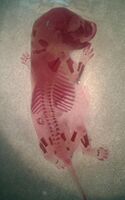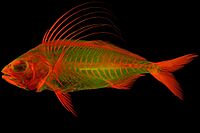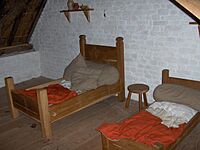Alizarin facts for kids
Quick facts for kids Alizarin |
|
|---|---|
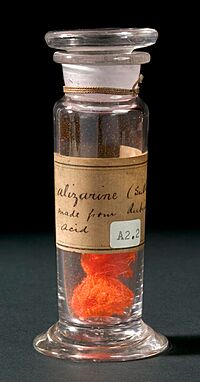 |
|
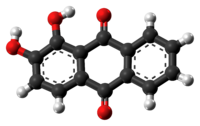 |
|
|
Preferred IUPAC name
1,2-Dihydroxyanthracene-9,10-dione
|
|
| Other names | 1,2-Dihydroxy-9,10-anthracenedione 1,2-Dihydroxyanthraquinone Turkey red Mordant red 11 Alizarin B Alizarin red |
| Identifiers | |
| CAS number | |
| PubChem | |
| KEGG | C01474 |
| ChEBI | CHEBI:16866 |
| SMILES | O=C2c1ccccc1C(=O)c3c2ccc(O)c3O |
|
InChI
InChI=1/C14H8O4/c15-10-6-5-9-11(14(10)18)13(17)8-4-2-1-3-7(8)12(9)16/h1-6,15,18H
|
|
| Beilstein Reference | 1914037 |
| Gmelin Reference | 34541 |
| 3DMet | B00298 |
| Properties | |
| Molecular formula | |
| Molar mass | 0 g mol-1 |
| Appearance | orange-red crystals or powder |
| Density | 1.540 g/cm3 |
| Melting point | |
| Boiling point | |
| slightly to sparingly soluble | |
| Acidity (pKa) | 6.94 |
| Except where noted otherwise, data are given for materials in their standard state (at 25 °C, 100 kPa) | |
Alizarin is a bright red dye that has been used for thousands of years to color fabrics and create paint. It is an organic compound, which means it's a chemical based on carbon. For most of history, alizarin was made from the roots of the madder plant.
In 1869, scientists discovered how to make alizarin in a lab. This made it the first natural dye to be created artificially. Today, alizarin is still used in art and science. For example, it helps scientists study bones by staining them red! It is also known by other names, like Turkey Red and Mordant Red 11.
Contents
A Colorful History
From Ancient Times to Red Coats
People have used the madder plant to make red dye for a very long time. It was used in ancient Egypt over 3,500 years ago. Dyed cloth was even found in the tomb of the famous Pharaoh Tutankhamun! The dye was also popular in ancient Athens and Corinth.
During the Middle Ages, the famous ruler Charlemagne encouraged people to grow madder plants. The dye was very valuable for coloring clothes. In the 1600s, alizarin was used to dye the red uniforms of the New Model Army in England. This is how English soldiers got their famous nickname, "redcoats."
To make the dye stick to cloth, dyers used a special substance called a mordant. Depending on the mordant, the color could be pink, purple, or even dark brown. The most famous color was a brilliant red called Turkey Red, which was made using a special process that came from the Middle East.
Creating the First Synthetic Dye
For centuries, the only way to get alizarin was from madder roots. But in 1826, a French chemist named Pierre-Jean Robiquet discovered that the root had two dyes: the long-lasting alizarin and a faster-fading dye called purpurin.
Then, in 1868, a huge breakthrough happened. German chemists Carl Graebe and Carl Liebermann figured out how to make alizarin from anthracene, a chemical found in coal tar. An English chemist, William Henry Perkin, discovered the same thing at almost the exact same time!
This new, man-made alizarin was much cheaper to produce than the natural version. Soon, farmers stopped growing madder plants because the synthetic dye took over the market. This discovery changed the dye industry forever.
What is Alizarin Like?
Alizarin is usually an orange-red powder or crystal. It is a type of molecule called a dihydroxyanthraquinone. There are ten different versions, or isomers, of this molecule. An isomer is like having building blocks that can be arranged in different ways to make different shapes, even though you use the same number of blocks.
One of the coolest things about alizarin is that it's a pH indicator. This means it changes color depending on whether it's in an acidic or a basic solution. This property makes it useful in science experiments.
How is Alizarin Used Today?
Even though it's an old dye, alizarin is still very important in science, medicine, and art.
A Tool for Scientists
Scientists use a special stain called Alizarin Red to study how bones grow. When alizarin is added to cells that are forming bone, it stains any calcium deposits a bright red color. This allows researchers to see bone formation happening right in the lab!
This staining ability was first noticed in 1567, when animals that ate madder plants grew red teeth and bones. Today, this property helps scientists study:
- Bone growth and diseases like osteoporosis
- How new tissues are made (tissue engineering)
- Calcium deposits in the body
In Geology and Art
Geologists use alizarin to tell different minerals apart. It helps them identify calcium carbonate minerals like calcite and aragonite in rocks.
Painters have used a pigment made from alizarin, called madder lake, for centuries. It was used to create beautiful, long-lasting red colors in famous paintings. You can see it in works by artists like Johannes Vermeer.
See also
- 1,2,4-Trihydroxyanthraquinone or purpurin, another red dye that occurs in madder root
- Alizarine ink
- Aniline
- Dihydroxyanthraquinone
- Hydroxyanthraquinone
- List of colors (compact)
- List of dyes
- Diaphonization
- Red pigments



